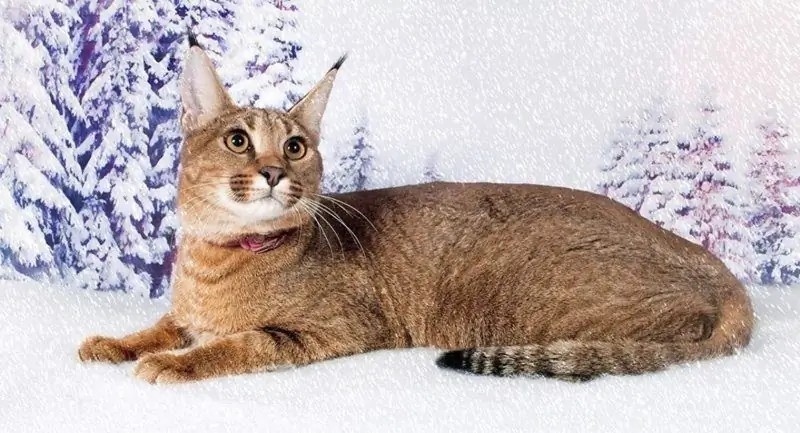
Table of contents:
- Author Bailey Albertson [email protected].
- Public 2023-12-17 12:53.
- Last modified 2025-06-01 07:32.
Expensive cat with a unique origin - caracat breed

Wild and exotic breeds of animals that have been tamed and domesticated have always captured humans. Perhaps this is a primal passion, where man is the crown of nature, who can cope with the most dangerous beast. But today the demand for "non-standard" pets has grown with extraordinary force. Quite recently, an amazing breed of cats was bred, which is called a caracat.
Content
- 1 Origin of the breed
- 2 What does a karaket look like
-
3 Character of the animal
3.1 Video: karaket kittens play by the pond
- 4 Health
- 5 Features of purchasing karaket kittens
-
6 Features of caring for a caracat
- 6.1 Games
- 6.2 Hygiene
- 6.3 Feeding
- 6.4 Toilet
- 7 Breeding features
The origin of the breed
Caracat is a hybrid obtained by mating a domestic cat with a wild African caracal cat, which is also called the steppe lynx. Today the caracat cat is considered the most beautiful, rare and expensive breed in the world. For the first time this hybrid was obtained as a result of accidental crossing of a caracal with a domestic cat in the Moscow Zoo back in 1998. After that, 9 years later, the first planned mating of a caracal with an Abyssinian cat was carried out in the United States in order to breed an exotic breed. As a result of the experiment, the generation of a karaket (F1) was obtained, there was one kitten in the litter. Unfortunately, American specialists were unable to create healthy, stable offspring and work on the project was closed.
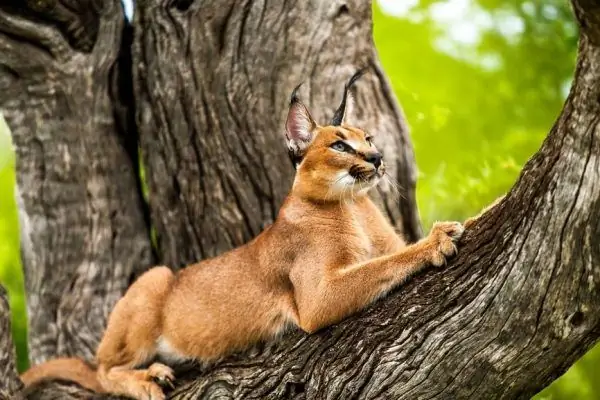
Caracal is a wild steppe cat, crossing with which allowed to obtain a unique breed of Caracat
After another 7 years, already in 2014, the Russian felinologist Irina Nazarova, in the course of crossing the steppe lynx with a domestic cat, received healthy offspring. The hybrid was recognized as an experimental breed by the international organizations ICU and TICA and became an official breed. There are several generations of karakets:
- F1 - the genotype of kittens have 50% lynx and are the offspring of direct crossing of a caracal and a domestic cat;
- F2 - an African wild cat admixture is 25%, this is a litter of a cat that has an F1 generation with a regular cat. Such kittens are several times cheaper, but exoticism in this breed is much less;
- F3 - obtained by crossing a female of the F2 generation with an ordinary male. In this case, the caracat will belong to the wild breed only by 16%;
- F4 is the lowest generation, which results from the mating of a female caraquette of generation F3 with a male of another breed. A kitten with generation F4 will only be 6% Wild.
What does a karaket look like
One litter can contain from one to five caraquette kittens, the weight of a newborn animal is not less than 115 grams. Even blind babies have funny, almost horizontal ears, black on the outside. At this age, there are no brushes, the breed is given by spots on the tummy and legs. Two weeks later, small carakets open their eyes, and by the 25th day of life they stand well on their paws and take their first steps. By the month, the size of the kitten's ears doubles, small brushes up to 0.5 centimeters long begin to grow from their tips. At this age, the cat looks more like its wild ancestor with almond-shaped eyes of rich honey or blue-green color.
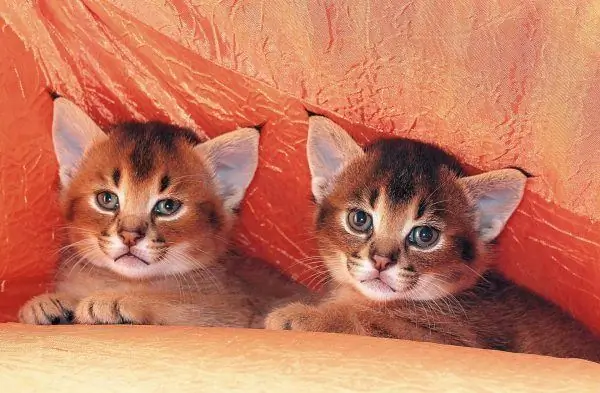
From the age of one month, kittens begin to grow brushes on their ears and they become more and more similar to their wild parent.
As the caraquette grows older, its color changes, the spots on the body brighten, and the soft, pleasant to the touch wool acquires a uniform color. Most often, the color of the animal is bright, deep and rich, from peach to red, which gives the large cat an even more wild look. The animal has a beautiful, well-proportioned muscular body and fluffy strong legs, thanks to which the grace with which the cat moves is unique. The Karaket can make long and accurate jumps up to 2 meters. All representatives of the breed have a physiological feature that refers the cat to its wild ancestors - a fat fold on the stomach, the same as that of the caracal.
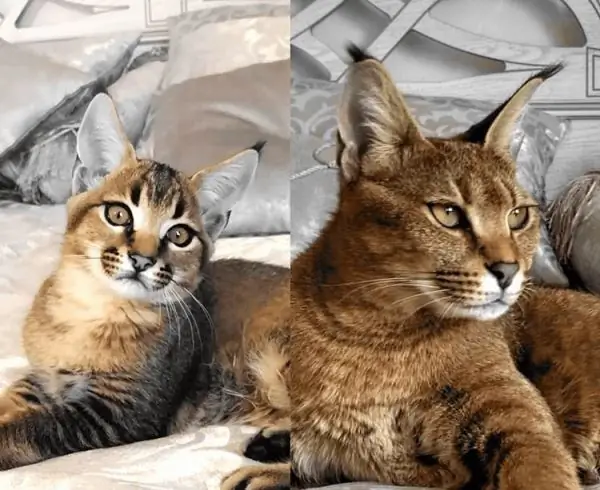
Caraquets have a very bright and rich coat color in shades of orange, which makes them visually more wild
The weight of an adult cat can reach 15 kilograms, on average a caracat weighs 9-12 kilograms, while the height of the animal at the withers can vary from 40 to 55 centimeters. The length of the body reaches 90 centimeters, and if you measure the cat from the tip of the nose to the tail, you can get about 130 centimeters. An adult animal has a large body with a small head, on which large ears are high, light from the side of the auricle and dark from the outside. Hybrid cats have expressive eyes and a wide nose with a large lobe, on which a light spot may be present. The tail and feet often have black horizontal stripes that blend in with the coat color with a gradient.
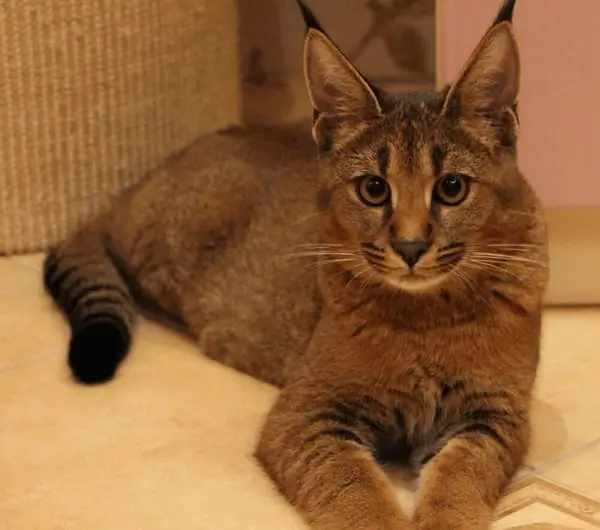
The karaket has horizontal stripes on the legs and tail, smoothly turning into the main color of the coat
Character of the animal
One very interesting feature of the karakets is that these cats do not know how to utter the usual “meow”, instead they snort, whine, hiss and squeak very gently. Little kittens almost immediately begin to actively "talk", making squeaking sounds provided they are completely safe and hissing when something scares them. A new toy, a stranger or another pet can make a baby caraquette afraid, but the cats of this breed quickly adapt to new conditions and, making sure that nothing threatens them, continue the game. Even small kittens have a very sensitive hearing, which determines their character, they can distinguish the smallest noises at a distance of up to 60 meters.
Despite their hunting skills and passion for active games, karakets are friendly and not capable of aggression outside the game. Like all domestic cats, familiar to everyone, carakets are very affectionate, they love attention and can come for a portion of love without an invitation. They sleep with pleasure on the owner, wrinkle their paws, rub and purr when they like something. Although temperament depends more on the particular cat, friendliness is a typical trait of the breed. When a stressful situation arises, the caracat can defend its owner or someone from the family members, exposing its claws and making hissing sounds.
Generally speaking, these are obedient, very intelligent animals that are great for family life. They get along well with young children and other pets, as long as there is no aggressive behavior towards them. Another interesting feature of this breed is that cats move very quietly, and not only during the game.
Video: karaket kittens play by the pond
Health
All karakets have very good health, which they inherited from the wild steppe cat. They are endowed with a good digestive system that allows them to digest raw meat and bones with ease. These animals are highly resistant to extreme conditions; they can be without food and water for a long time. Strong immunity makes the pet resistant to most feline diseases. At the same time, systematic comprehensive vaccinations against viral diseases and rabies must be carried out in a timely manner, especially if the caracat is taken out for a walk on the street. The lifespan of cats and cats of this breed has not been established, since the pets were bred quite recently. However, it is believed that a large animal lives several years less than a common domestic cat.
Features of purchasing karaket kittens
When purchasing caracat kittens, there are no questions about how to choose the best from a variety of offers. Today there is only one main nursery, where the breed was bred - Kataleya. There are also subsidiary catteries that work in some cities of Russia, following the instructions of Kataleya and using the cats they bred:
- VIVAT CARACAT - St. Petersburg;
- CARACAT ANGARA - Irkutsk;
- ALTAY CARACAT - Barnaul.
By purchasing a karaketa kitten, the new owner receives the following documents:
- veterinary passport;
- pedigree with ICU and TICA certificates;
- microchip data;
- pet purchase and sale agreement.
If necessary, the breeder gives in a convenient form recommendations for the care and education of an exotic kitten. The new owner will receive information about the vaccinations carried out, as well as the results of pet analyzes. Karaket kittens are sold at the age of 3.5-4.5 months and only on condition that they are accustomed to the litter box, adapted to live in a family with children and eat solid food. The cost of a karaket can vary from the type of generation and be $ 10,000-20,000. Kittens purchased from the breeder are neutered and unsuitable for independent breeding.
Features of caring for a caracat
Caraquets are specific cats that have non-standard sizes and physical characteristics that distinguish them from their usual pets. This breed requires special conditions for keeping, which are determined by the way of life. For them, physical activity and active games are important, so you should take care of a "sports" ground in advance, where the animal can surprise with its achievements. When purchasing a karaket, you need to know in advance everything about caring for it - from feeding to parenting methods.
Games
In no case do not use your own hands and feet when playing with a kitten, as a grown-up karaket can seriously harm its owner during the game. Toys for dogs are best suited for playing - these are all kinds of balls and flies. Feather flies are suitable only for kittens up to 3-4 months old, after which the animal can easily destroy the toy in a matter of seconds. Give preference to everything that is durable, experiment, and do not leave the tools for games within the reach of the karaket. If the toy is always in sight, the cat will quickly lose interest in it and will not show activity.
Representatives of the breed have good fun at special sports complexes that are well fixed. For young karakets, systems consisting of low blocks are needed, since the animal likes to jump not only forward, but also upward. Jumping too high can lead to injuries, so increase the load and increase the size of the playing field in accordance with the age of the pet. Joint walks on the street will be beneficial, for which they use special reinforced harnesses that can withstand a weight of up to 15 kilograms.

To walk with a caracat, you need a special harness designed for animals up to 15 kg
Hygiene
Despite the smooth coat, karakets must be systematically combed out, at least once a week. In the summer they have a molting period and the kitty will have to comb out more often, preferably every day. You should not bathe a kitten more than once every three months, and after bathing it is important to make sure that the animal does not blow. As the karaket grows up, water procedures can be carried out as needed, for example, after a walk on the street. Exotic cats are very fond of water and are happy to resort to water treatments.
Feeding
There are two feeding strategies for karakets - feeding with dry food and feeding with natural products. When using commercially available food, you should give preference to formulations of the lap class and buy those options that are intended for decorative, exotic and wild cat breeds. The following foods are best suited for caraquets:
- Carnilove Lamb Wild Boar Sterilized;
- ACANA Wild Prairie;
- "Carnilove Large Breed".
Breeders recommend feeding the cat with natural products, combining meat, cereals, plant foods and milk. Carakets are fed mainly with meat - it can be turkey, quail, chicken, beef, rabbit. Products must be given raw; for your own peace of mind, it is allowed to pour boiling water over individual raw pieces. Babies up to six months are fed 3 times a day, from 6 to 12 months - 2 times, and starting from a year they are transferred to a one-time meal. From cereals you can cook oatmeal, millet, corn, buckwheat and rice are undesirable. Be sure to need eggs, cottage cheese, vegetable fats, you can add a small amount of olive or sunflower oil to the porridge.
The optimal amount of food consumed during the day should not exceed 5-7% of the animal's weight. At first, while the caracat is still a baby, all the food needs to be chopped up by small slicing, and starting from 6 months you can not worry about the pet, entrusting him with large pieces. It is imperative that the animal has free access to clean water, it is best to use filtered or bottled water. As for unwanted products for caracets, these are:
- pork;
- pure cow or goat milk;
- fried foods;
- sweet;
- roots.
Restroom
Caraquets are very smart animals, they easily get used to the tray with any filler, be it gel or wood. As a rule, the breeder himself teaches the animal to the toilet and by purchasing a kitten you get a tray to which the baby is already accustomed. It is best if the tray is located close to the place where the domestic predator spends a lot of time. If there is a free room in the house, the cat will have to allocate it by installing a play complex there, a bowl for food and water, and a pot. In most cases, there are no problems with karakets in terms of toilet training, they themselves find a tray and relieve themselves there. The main thing is not to forget to change the filler in a timely manner, since this exotic cat will not go into a dirty pot.
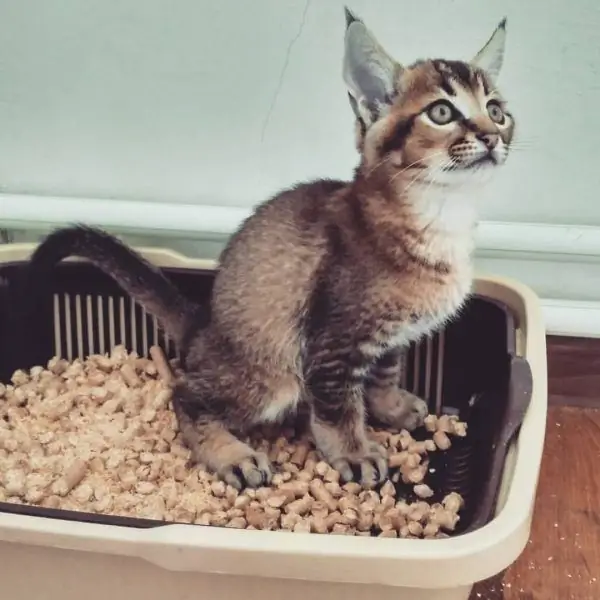
Caraquets love cleanliness and can easily find litter boxes in new homes.
Breeding features
Caraquets are a very rare breed because the problem of their breeding remains relevant. On the territory of Russia, one main nursery and several subsidiaries are engaged in breeding this breed, spending all their energy and time on effectively solving the problems of hybrid breeding. Each mating is a genetic experience that does not guarantee 100% of the result, since the whole procedure consists of many nuances. For example, it is necessary to create special conditions for a wild cat to impregnate a domestic cat, since this is impossible in real conditions. Caracal (wild steppe cat) does not burn with great love for small animals. In this matter, diet, living conditions of pets, their psychological and physical condition are strictly important. After mating, a cat can produce from one to five purebred kittens,which, after birth, during the first weeks, will practically not give out in themselves elite karakets. Boys are sterile, and girls are sold only with the condition of sterilization, without the right to breed, so the specifics of conception and pregnancy were not disclosed.
Caracat is an exotic cat breed that was bred by mating a domestic cat with a caracal (African steppe cat). This is the rarest and most expensive cat breed in the world. On the territory of Russia, no more than 100 karakets live, which are limited in breeding. This is a large and very active animal that requires a special attitude and living conditions that the pet will have to provide.
Recommended:
Savannah: Description Of The Cat Breed, Features Of Care And Maintenance, Photos, Reviews Of Cat Owners
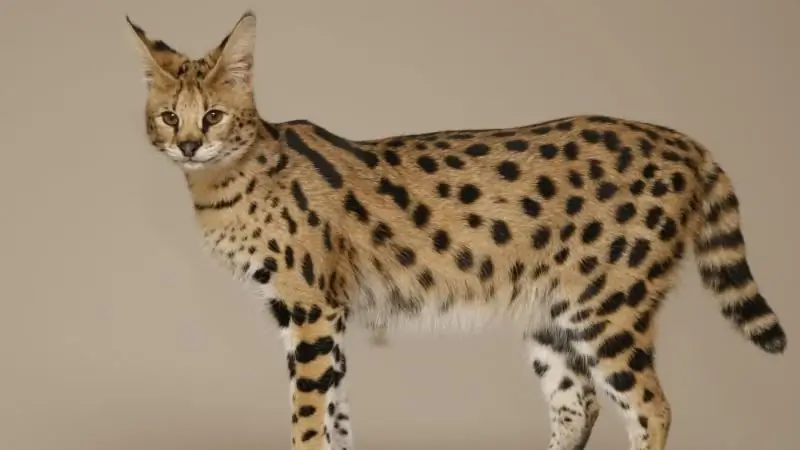
History and origin of the Savannah breed. Differences from other breeds. Features of character, upbringing and care. Choosing a kitten. Breeding animals. Reviews of the breed
Angora Cat: History Of The Breed's Origin, Appearance And Photos, Features Of Character And Care Of The Cat, Reviews Of The Owners
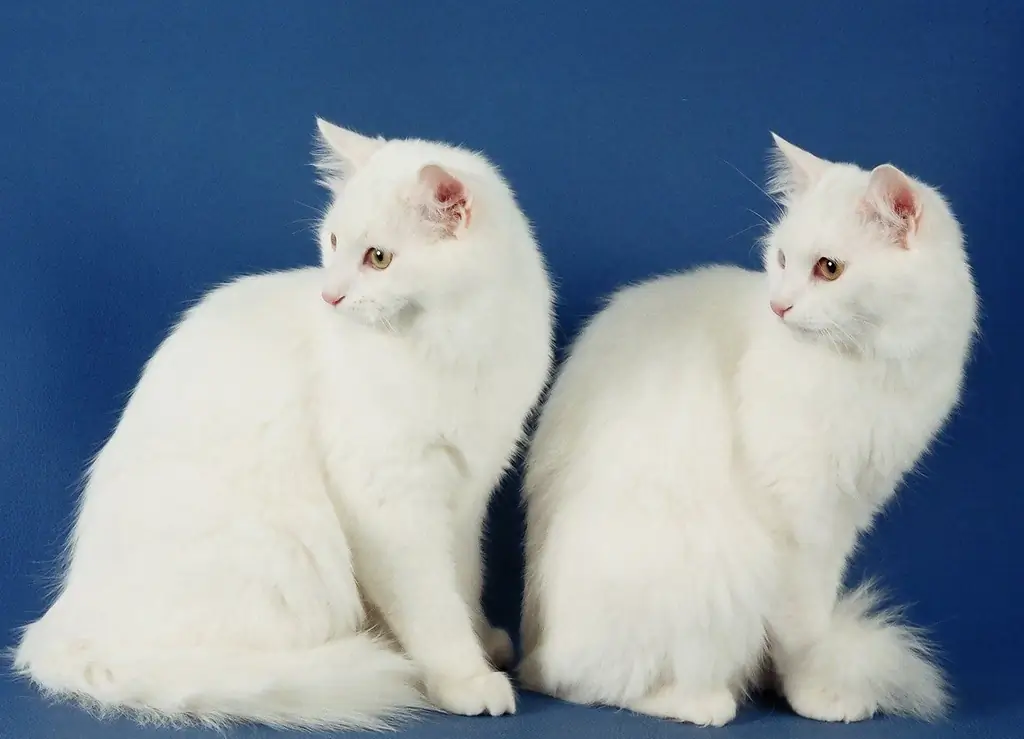
History of the Angora breed. Features of appearance and character. Disadvantages of the breed. Proper care and feeding. How to choose a kitten. Breeding the breed. Reviews
Belgian (Bengal Cat): Description Of The Breed, Character And Habits, Maintenance And Care, Owner Reviews, Photos
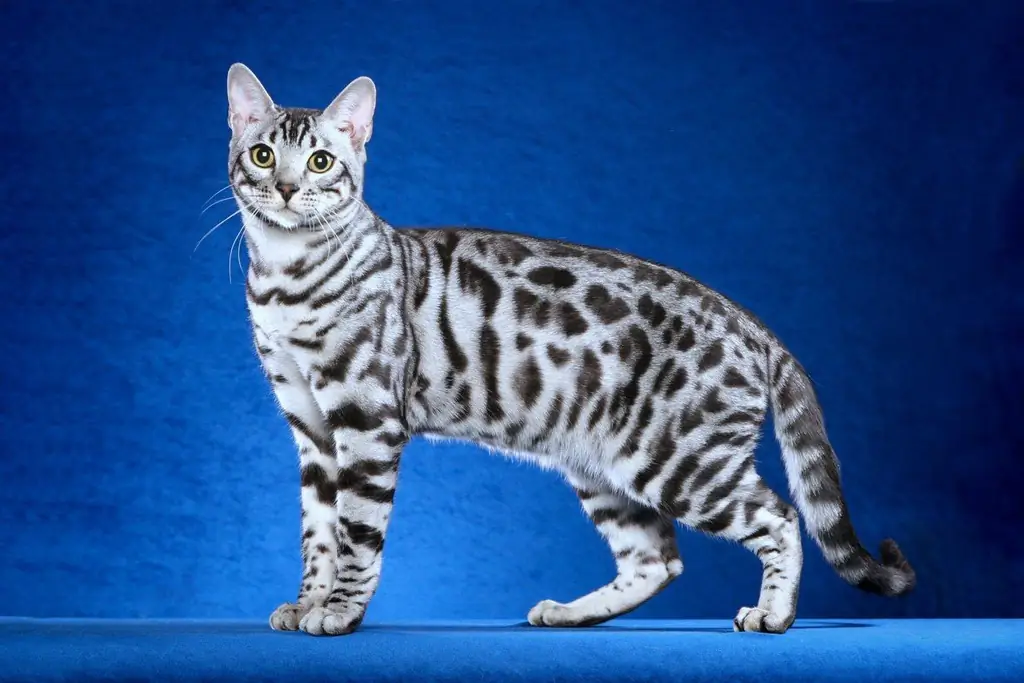
The history of the origin of the breed. The appearance of a Bengal cat. Bengal character. Health. How to take care of your pet. How to choose a kitten. Reviews
Anatolian Cat: Features Of The Breed's Appearance, Care And Maintenance Of The Cat, Character And Habits, Breeding Pets, Owner Reviews

Where the Anatolian breed is bred. The main external differences, the nature of the pet. How to properly care for him, feed him. How to choose a kitten. Breeding. Reviews
Cornish Rex: Description Of The Breed With Photos, Character And Habits, Care And Maintenance, Reviews Of Cat Owners
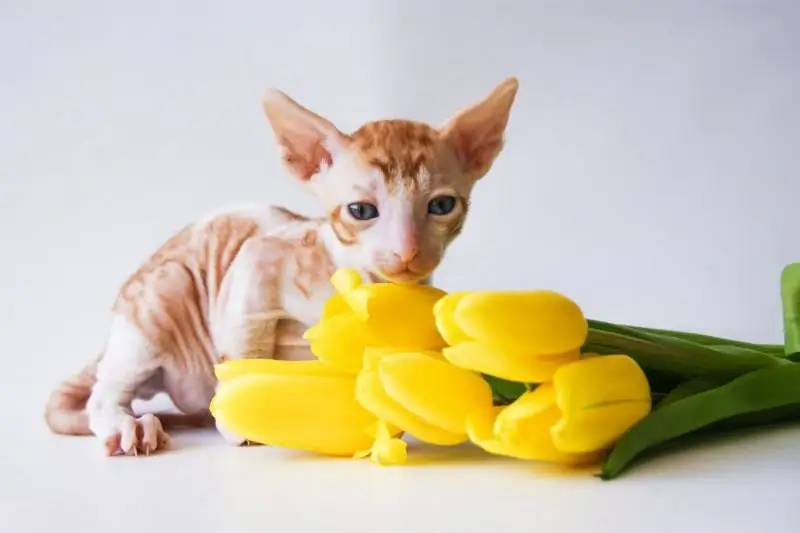
The history of the origin of the breed. What does a Cornish Rex look like? The nature of the cat. Care rules. What to feed the Cornish Rex. Reviews, photos and videos about the breed
